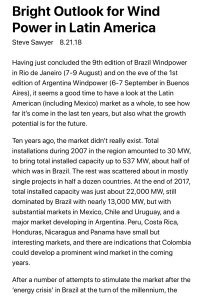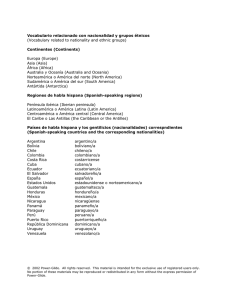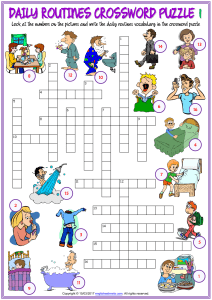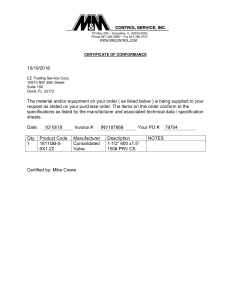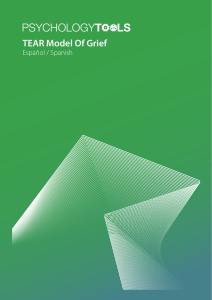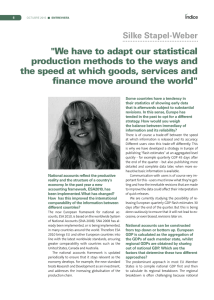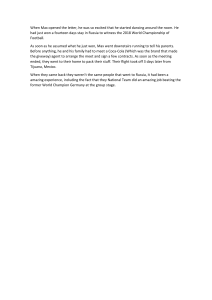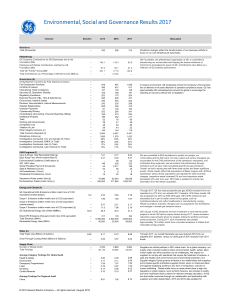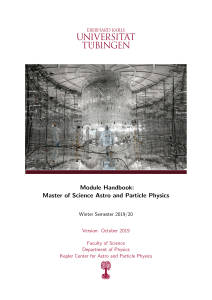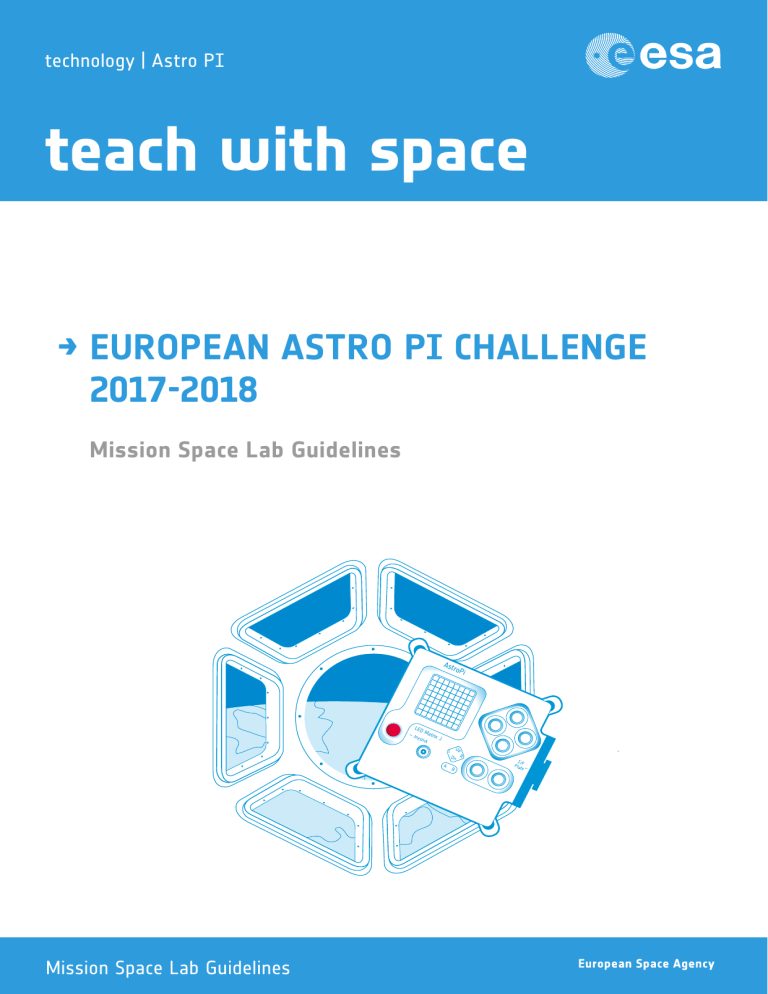
technology | Astro PI teach with space → EUROPEAN ASTRO PI CHALLENGE 2017-2018 Mission Space Lab Guidelines Ast roP i _ LED M atrix Joy L stic k L Up Dn R A Mission Space Lab Guidelines B I/ Pla F _ te 1. Introduction ESA’s Education Office in collaboration with the Raspberry Pi Foundation (RPF) is challenging teams of school students who are 19 years and younger to join the European Astro Pi Challenge – Mission Space Lab, and to design a scientific experiment which requires the exclusive use of one of the two Astro Pi computers and their sensors onboard the International Space Station (ISS). The best experiments/codes that respect the rules and mission requirements described below will be run on the ISS! 2. Mission Space Lab overview The Mission Space Lab consists of four phases that the student teams have to be prepared to go through: • Phase 1 – Design your idea for an experiment • Phase 2 – Create and test your experiment/code • • Phase 3 – Run your experiment/code on the ISS Phase 4 – Analyse your data Phase 1 – Design your idea for an experiment (25 September – 29 October 2017) In this phase, which will take place between 25 September and 29 October 2017, teams will have to demonstrate their motivation to compete in the Challenge by planning an experiment. In this phase, no coding is needed, only an idea for an experiment! Teams will have to come up with and develop an idea for an experiment that fits one of the following two themes: Theme A – Life in space Teams that choose to investigate ‘Life in space’ will have to make use of the Astro Pi Ed, located in the Columbus module, to run their investigation. Teams can use all the Astro Pi Ed’s sensors (that is the Astro Pi ‘Sense Hat’) and the visible camera. The visible camera can ONLY be used as a sensor (for instance as a luminosity sensor), as pictures inside the Columbus module are not allowed for crew privacy reasons. Theme B – Life on Earth Teams that choose to investigate ‘Life on Earth’ will have to make use of the Astro Pi Izzy, located in an ISS module, to run their investigation. Teams can use all of the Astro Pi Izzy sensors (that is the Astro Pi ‘Sense Hat’) and the infrared camera. The camera will be aimed (pending ISS operational constraints) directly down at Earth through a window, allowing various kinds of Earth observation experiments to be done. teach with space – Mission Space Lab guidelines 2 A blue filter is also installed on the Astro Pi Izzy camera. This same filter is provided in the Astro Pi kit which will be distributed by ESA to the teams accepted for Phase 2 (blue filter data sheet available here). When developing their idea, teams should take into consideration the fact that the infrared camera on Astro Pi Izzy will be fitted with the blue filter. Teams have until 29 October 2017 to register and submit their idea on the Astro Pi website (see chapter 4 ‘How to submit your entry’). When submitting their idea, teams must: • • • indicate which theme (A or B) their experiment will investigate, describe their experiment (maximum 200 words), and explain how they will use the Astro Pi to perform their experiment (maximum 200 words). Teams’ ideas will be evaluated based on their: • • • • Scientific value Creativity and originality Feasibility of the experiment within the ISS environment Conformity with the chosen theme (A or B) The selected teams will be notified on their acceptance to Phase 2 by 7 November 2017. Phase 2 – Create and test your experiment (7 November 2017 - 7 February 2018) In Phase 2, which will take place between 7 November 2017 and 7 February 2018, the selected teams will write the computer code necessary to execute the idea for the experiment that they suggested in Phase 1. Teams selected to participate in Phase 2 of the challenge will receive an ESA-branded Astro Pi kit directly at their school (unless the team’s teacher already received a kit during the 2016-2017 Challenge). The kit contains the equipment necessary for the teams to test their codes except for the monitor, USB keyboard, and mouse, which the teams will have to provide themselves. The deadline for submissions through the Astro Pi website is 7 February 2018. When submitting their computer code, teams will also have to: • • • describe the main objectives they have identified for their mission; describe the methodology used to investigate their objectives; present their prediction of the ISS results. See chapter 4 (‘How to submit your entry’). teach with space – Mission Space Lab guidelines 3 Phase 3 – Run your experiment on the ISS (8 February – 9 May 2018) In this phase, an evaluation panel composed of ESA, the Raspberry Pi Foundation (RPF), as well as other national experts, will select the experiments and codes per country that will be sent to the ISS. On 20 February 2018 the selected teams will be announced. The selected entries will be uplinked to the ISS and run on Astro Pi Ed and Astro Pi Izzy. The experiment codes will be run on the ISS from mid-April to the beginning of May 2018 (pending ISS operational constraints). After the codes are run, the data collected in orbit will be downlinked and distributed to the participating teams. Phase 4 – Analyse your data (10 May – 11 June 2018) This year, for the first time, teams will be challenged to submit a final report that includes an analysis of their data collected on the ISS. Only teams that submit their final report will receive the official Astro Pi Challenge Winner Certificate! The 10 teams that submit the best reports will also get a special mention and receive a special prize. In due time, ESA will provide guidelines as well as a template to complete and submit the final reports required. The deadline to submit the final reports is 11 June 2018. 3. Who can participate in the Challenge? All the following eligibility conditions have to be fulfilled: • Participation is open to teams of students up to and including 19 years old. • Each student team must be composed of a minimum of 2 students, up to a maximum of 6 students. • At least 50% of the team members must have the nationality of an ESA Member or Associate Member State1 . • Team members must meet one of the following requirements: a) be enrolled full-time in a primary or secondary school located in an ESA Member or Associate Member State; ESA will also accept entries from primary or secondary schools located outside an ESA Member or Associate Member State only if such schools are officially authorised and/or certified by the official Education authorities of an ESA Member or Associate Member State (for instance, French school outside Europe officially recognised by the French Ministry of Education or delegated authority). b) be home schooled (certified by the National Ministry of Education or delegated authority in an ESA Member or Associate Member State). c) be a member of a science/code club, enrolled full-time in a primary or secondary school in an ESA Member or Associate Member State. ESA Member States in 2017: Austria, Belgium, Czech Republic, Denmark, Estonia, Finland, France, Germany, Greece, Hungary, Ireland, Italy, Luxembourg, the Netherlands, Norway, Poland, Portugal, Romania, Spain, Sweden, Switzerland, United Kingdom. ESA Associate States in 2017: Canada, Slovenia 4 teach with space – Mission Space Lab guidelines 1 • • Each team must be supervised by a teacher or mentor acting as the team’s point of contact with ESA’s Education Office. One teacher/mentor can be responsible for a maximum of five teams per year (each teacher will only receive one Astro Pi kit). There is no limit to the number of teams a school or club can enter, but each student can only be part of one team. Each team can only submit one entry. 4. How to submit your entry In Phase 1 (25 September – 29 October 2017), teams have to register and submit their original idea for an experiment online (through https://astro-pi.org/missions/space-lab/submit-idea/). The deadline is 29 October 2017. In Phase 2 (7 November 2017 – 7 February 2018), the selected teams must submit online (the link will be provided at the kick-off of Phase 2) the experiment they propose to accomplish (their ‘mission’), as well as the computer codes necessary to operate Astro Pi. To upload their code, teams have to put it into a zip or tar file. The deadline is 7 February 2018. In Phase 3 (8 February – 9 May 2018), student teams are not requested to submit an entry. In this phase, the evaluation panel will select the experiments that will run on the ISS and will announce the results on ESA’s Education website on 20 February 2018. The selected experiments will then be run on the ISS and the data collected will be sent to the student teams. In Phase 4 (10 May – 11 June 2018), teams will have to submit online (the link will be provided at the kick-off of Phase 4) a final report using a document template to be provided by ESA. The deadline is 11 June 2018. All entries for the different phases must be submitted in English. Entries that are not submitted using the links hereby provided will not be accepted. teach with space – Mission Space Lab guidelines 5 5. Mission requirements and constraints When designing their experiment/mission and writing the code to execute it, teams have to respect the following rules to guarantee the feasibility of their mission: • • • The experiment must be related to the themes (A or B) of the Challenge; Considering the busy schedules of the astronauts, the Astro Pi on the ISS will be controlled from the ground without the involvement of the crew. For this reason: o Astronaut interaction with the Astro Pi through a joystick, buttons, or in any other way cannot be considered in the proposed mission design and execution code; o The Astro Pi’s cannot be moved from and around their fixed position on the ISS. Due to the multiple experiments taking place on the ISS in the timeframe of the Challenge, and considering the very limited space available onboard, the exact location of the Astro Pi’s will be known only shortly before the student experiments’ execution; The code must respect the Mission Space Lab code rules. 6. Mission tools and supporting resources Astro Pi is the only hardware teams will have at their disposal to run their Space Lab mission, and computer programming/coding is their only tool. No other hardware or equipment is foreseen. Teams can test what it is possible to do with the Astro Pi and its sensors (the Sense HAT) using the Astro Pi Sense HAT web emulator. Remember that, if you choose Theme A, the visible camera can ONLY be used as a sensor (for instance as a luminosity sensor), as pictures inside the Columbus module are prohibited for crew privacy reasons. Teams selected to participate in phase 2 will receive an Astro Pi Kit which contains the same hardware that is onboard the ISS and that is necessary for teams to create their experiment (except for the monitor, USB keyboard, and mouse, which the teams will have to provide themselves). Teachers can find resources that explain how to use the Astro Pi here. ESA will also provide classroom resources and a webinar for teachers on how to use the Astro Pi cameras by mid November 2017. 7. Questions? Any questions regarding the European Astro Pi Challenge should be sent to astropi@esa.int. For questions related with Astro Pi hardware please check the FAQ section for mission Space Lab in the Astro Pi website at Raspberry Pi Foundation, or join the Astro Pi forums. If you can’t find the answer you’re looking for, please send an email to enquiries@astro-pi.org . teach with space – Mission Space Lab guidelines 6
